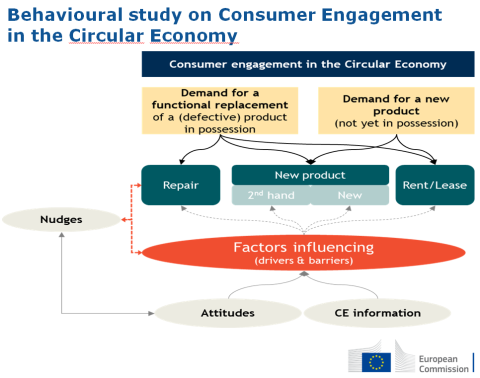Behavioural Study on Consumers’ Engagement in the Circular Economy
Behavioural Study on Consumers’ Engagement in the Circular Economy
To obtain empirical policy-relevant insights to assist with the implementation of the EU Circular Economy Action Plan, the European Commission requested a behavourial study that aimed to:
- identify barriers and trade-offs faced by consumers when deciding whether to engage in the CE, in particular whether to purchase a more or a less durable good, whether to have a good repaired, or to discard it and buy a replacement;
- establish the relative importance of economic, social and psychological factors that govern the extent to which consumers engage in the CE, especially purchasing durable products and seeking to repair products instead of disposing of them; and
- propose policy tools to enable and encourage consumers to engage in CE practices related to durability and reparability.
The study focused on five products: vacuum cleaners, televisions, dishwashers, smartphones and clothes. The methodology encompasses a systematic literature review, 50 stakeholder interviews, consumer focus groups, an online consumer survey with 12,064 participants, and a behavourial experiment with 6,042 participants. Whereas the survey collected information on consumers' perception of and experiences with circular practices, the financially incentivised experiments included a repairing and purchasing task.
Findings include a general willingness to engage but little practical action to date. Consumers appear to be hampered by insufficiently developed markets for repair, reuse and refurbish in addition to a lack of information regarding product durability and repairability. Such information appeared seminal in shifting purchasing decisions towards sustainable products in the behavourial experiment, highlighting great potential to bridge the gap between theoretical and practical engagement. This experiment also uncovered substantial consistency between a self-reported circular mindset and corresponding behaviour.
As product size and price increases, consumers also appear to have greater interest in repairability and durability. Whereas repairability is linked to spare parts, durability appears to follow from perceived product quality. Overall this study concludes that the price-quality ratio, followed by convenience, is the most important driver and simultaneously barrier for consumer engagement in the circular economy. Building on these finidngs, the study makes 5 recommendations for policy action to enhance consumer engagement in the circular economy:
- boost CE engagement by increasing awareness of the circular economy;
- make repairing products easier;
- create financial incentives for repairability and durability;
- make information on durability and repairability available at point of sale;
- strengthen legislation requiring the provision of accurate information to consumers.

